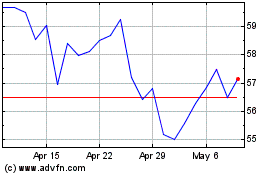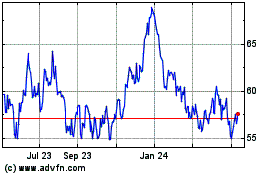By Paul Kiernan
RIO DE JANEIRO--Brazil's government said it is preparing to sue
mining giants Vale SA, BHP Billiton Ltd. and their joint venture
Samarco Mineração SA in response to a catastrophic dam failure
earlier this month, as Vale acknowledged the presence of toxic
elements in a river downstream for the first time.
The civil suit demanding damages of 20 billion Brazilian reais
($5.3 billion) is expected to be filed on Monday, the Attorney
General's office said on Friday in a news release. The proceeds are
intended to create a fund to help recovery efforts in the Rio Doce,
a major river that was contaminated with mud and toxic mining waste
in the wake of the Nov. 5 collapse of Samarco's dam in Minas
Gerais.
As many as 13 people were killed and hundreds displaced as the
mud swallowed up entire villages below the dam. An additional 11
are missing.
The lawsuit will represent by far the biggest government
response yet to what is widely considered one of Brazil's worst
environmental disasters. Environmental agency Ibama had previously
announced a fine of 250 million reais, while prosecutors secured a
preliminary commitment from the mining companies to create a
1-billion-real emergency fund.
The amount of damages sought, the Attorney General's office
said, "is preliminary and could be raised over the judicial
process, since the environmental damages of the mud's arrival at
the ocean have not yet been calculated."
Vale's admission about the river contamination came two days
after a United Nations report alleging "high levels of toxic heavy
metals and other toxic chemicals" in the Rio Doce and criticizing
the mining companies and the Brazilian government for their
"defensive" public response to the incident.
Vale, BHP Billiton and Samarco all say the tsunami of mud
unleashed by the dam break comprised water, mud, iron-oxide and
sand, none of which are harmful. In a news conference on Friday,
Vale executives continued to stress that was the case. But Vania
Somavilla, Vale's executive director of human relations, health and
safety, sustainability and energy, said the mud may have upset
toxic elements settled in the bed of the Rio Doce or along its
banks.
"In fact there was lead, arsenic--not mercury--detected in some
points along the river," Ms. Somavilla said. "When the dam breaks
and that stuff washes out the banks of the river, it could have
picked up some kind of material that was already present, from the
most diverse of origins, but they're all materials present in
nature."
She cited a report on the river's water quality after the
collapse by the Minas Gerais state Institute of Water Management,
or IGAM, or IGAM. The report was dated Nov. 17 but was only
published this week, after prosecutors ordered it to do so. A
spokesman for IGAM said he didn't know why the institute didn't
publish the report earlier.
The 29-page document includes samples collected at 12 points
along the Rio Doce between Nov. 7 and Nov. 12, as the mud from
Samarco's dam snaked downstream. At various collection points, the
report showed record levels of toxic metals.
Vale and BHP Billiton have attempted to distance themselves
legally from Samarco--a limited liability company they say is
independently run--while touting their contributions to recovery
efforts. The two companies said Friday they plan to create a
volunteer and nonprofit fund with Samarco to clean up the Rio
Doce.
Attorney General Luiz Inácio Adams said authorities are open to
the possibility of an agreement whereby the mining companies
propose initiatives themselves.
"[Samarco] has announced measures that show it is preoccupied
with recovering its image before society for the damage it caused,
which indicates there is an understanding attitude toward the
government," Mr. Adams was quoted as saying in the news release.
"If the willingness doesn't come, what we'll ask the judge to do is
to block the money by court order."
Brazilian authorities have come under fire for their reaction to
the catastrophe that, in the eyes of many critics, underscores
politicians' dependence on the mining industry for job creation and
tax revenue. Vale is the country's top exporter and is known to
donate millions of dollars to political campaigns.The mayor of
Mariana, where Samarco's dam stood, said shortly after the accident
that his town depends on mining for 80% of its revenue, making it
"hostage" to the industry. Citing more than 40 water samples
between Nov. 14 and 18 taken by federal agencies, the government
said Thursday that "there was not an increase in the presence of
heavy metals in the water and sediments." In a statement Friday,
the government said metals detected in the earlier tests by IGAM
had likely settled by the time its samples were collected.
Arsenic, which the World Health Organization says can cause skin
lesions, liver disease and cancer, was detected in the river at as
much as 108 times the legal maximum. Lead, which can cause brain
damage, was measured at as much as 165 times the legal maximum.
Copper, linked to gastrointestinal problems, was at as much as 75
times the limit. Chromium, which can cause gastrointestinal
disorders and hemorrhaging, was at as much as 57 times the limit.
Among the other metals detected were nickel, cadmium, manganese and
iron found at elevated levels.
Tests by a municipal water agency along the river, which were
sent to the U.N. Office of the High Commissioner for Human Rights,
also showed high levels of toxic elements such as arsenic on Nov.
10. This and other evidence prompted a blistering criticism of BHP,
Vale and the Brazilian government by U.N. special rapporteurs John
Knox and Baskut Tuncak on Wednesday.
"This is not the time for defensive posturing," Messrs. Knox and
Tuncak said, "It is not acceptable that it has taken three weeks
for information about the toxic risks of the mining disaster to
surface."
Brazil's Environment Ministry said Friday it expects the
revitalization efforts in the Rio Doce basin to take at least 10
years. The government may seek to hire workers in the communities
affected by the disaster, which is believed to have devastated
fisheries and other economic activity along the river, officials
said.
Write to Paul Kiernan at paul.kiernan@wsj.com
Subscribe to WSJ: http://online.wsj.com?mod=djnwires
(END) Dow Jones Newswires
November 27, 2015 19:28 ET (00:28 GMT)
Copyright (c) 2015 Dow Jones & Company, Inc.
BHP (NYSE:BHP)
Historical Stock Chart
From Mar 2024 to Apr 2024

BHP (NYSE:BHP)
Historical Stock Chart
From Apr 2023 to Apr 2024
